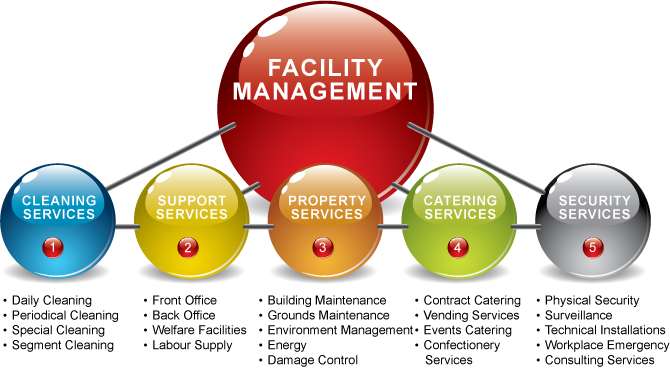Comprehensive Overview to Facility Management for Companies
Comprehensive Overview to Facility Management for Companies
Blog Article
Key Patterns Forming the Future of Center Administration in 2024
As we look ahead to 2024, the landscape of facility management is poised for considerable makeover, driven by a number of vital patterns. The combination of wise structure technologies and a shift towards data-driven decision-making pledge to boost operational efficiency while prioritizing sustainability in practice. The appearance of crossbreed job versions is improving workplace atmospheres, demanding cutting-edge layout options that provide to progressing staff member requirements. In the middle of these adjustments, the emphasis on resident wellness continues to gain traction, emphasizing the relevance of a healthy and balanced work environment. Exactly how these patterns will manifest in technique stays a vital question for industry specialists.
Smart Structure Technologies

Smart building technologies include a vast selection of systems, including smart lights, cooling and heating controls, and security systems. By incorporating these systems, facility supervisors can keep track of and change specifications in real-time, causing considerable decreases in power waste and functional expenses. Smart sensing units can discover occupancy degrees and change illumination and temperature appropriately, making certain that power is just utilized when needed.
Moreover, these innovations help with enhanced information collection, enabling organizations to track use patterns and identify possibilities for more renovations. The implementation of wise structure modern technologies not just adds to sustainability objectives but likewise creates much healthier work atmospheres that can enhance staff member efficiency and satisfaction.
As we move right into 2024, the adoption of clever building modern technologies will likely accelerate, mirroring a more comprehensive shift in the direction of more smart, responsive, and lasting facility monitoring practices.
Data-Driven Choice Making
Progressively, companies are leveraging data-driven decision making to boost facility monitoring practices. By harnessing data analytics, facility supervisors can obtain workable insights that dramatically enhance functional performance and resource allowance. The assimilation of advanced innovations, such as IoT sensing units and real-time monitoring systems, allows the collection of vast amounts of information on structure efficiency, occupancy rates, and power intake.
This wealth of info enables facility managers to determine fads, predict maintenance needs, and proactively address problems prior to they rise. Anticipating analytics can anticipate devices failings, lowering downtime and repair costs. Additionally, data visualization tools facilitate much better interaction amongst stakeholders, ensuring that informed choices are made collaboratively.
Furthermore, data-driven techniques boost strategic preparation by enabling facility managers to analyze the efficiency of present methods and make notified options relating to investments in innovation or facilities. As companies progressively focus on operational excellence, data-driven decision production is poised to end up being a cornerstone of successful center monitoring methods in 2024 and past. Eventually, the capability to take advantage of data efficiently will encourage companies to develop a lot more effective, productive, and resilient facilities.
Sustainability and Environment-friendly Practices
The focus on data-driven choice making naturally aligns with the expanding emphasis on sustainability and environment-friendly methods within facility management. As companies progressively prioritize environmental duty, facility managers are leveraging analytics to maximize resource usage, lower waste, and decrease carbon footprints. This strategic strategy allows the integration of energy-efficient systems, such as LED illumination, smart heating and cooling controls, and renewable power sources right into facility procedures.
Additionally, the implementation of lasting practices expands past power intake. Center managers are embracing environmentally friendly products and advertising recycling campaigns to produce a round economy within their centers. This not just boosts the ecological account of the company yet additionally fosters a culture of sustainability among staff members.
Conformity with environmental regulations is an additional critical facet driving the adoption of eco-friendly techniques. By utilizing data analytics, center managers can check compliance metrics and determine locations for enhancement, ensuring adherence to worldwide and local sustainability requirements.
Crossbreed Job Versions
A significant shift towards hybrid job versions this content is improving the landscape of center management in 2024. This paradigm incorporates remote and in-office work, requiring a reevaluation of room usage, source allowance, and staff member interaction approaches. Organizations are significantly recognizing the significance of adaptable work spaces that deal with diverse needs and preferences.
Center supervisors must adapt by implementing flexible workplace designs that sustain collaborative initiatives while providing areas for focused job. This consists of the integration of technology to promote seamless interaction and partnership amongst remote and in-office workers. Smart building remedies, equipped with sensing units and analytics, permit real-time surveillance of space use, allowing organizations to enhance their settings successfully.
Moreover, crossbreed job versions highlight the demand for reliable facility management that focuses on worker experience. This includes not only technology and room layout however also the development of plans that promote a well find out here now balanced work-life dynamic. As business browse this change, the role of facility monitoring comes to be critical in developing an agile workplace that promotes efficiency and drives organizational success. Essentially, the hybrid job model is transforming center management, motivating an aggressive technique to meet the developing demands of the labor force.
Boosted Resident Wellness
As organizations accept hybrid work versions, a heightened emphasis on passenger wellness is coming to be indispensable to center management strategies. Facility Management. This shift recognizes that a completely satisfied and healthy and balanced workforce directly impacts productivity and retention rates. Center supervisors are currently prioritizing settings that advertise physical and mental wellness, incorporating aspects such as natural lights, biophilic layout, and available wellness sources

Technology plays a vital duty in this evolution. Smart structure systems can check environmental aspects and adjust settings in real-time, making sure optimal convenience levels - Facility Management. Comments mechanisms, such as occupancy sensors and worker studies, allow facility supervisors to continuously improve wellness campaigns based on passenger demands.

Verdict
In 2024, the future of facility administration will certainly be considerably affected by the assimilation of smart structure innovations and data-driven decision-making, fostering improved operational efficiency. Sustainability initiatives will prioritize environmentally friendly methods, while the development of hybrid job versions will require adaptable workplace styles. Furthermore, an enhanced emphasis on owner wellness with sophisticated HVAC systems and biophilic style will certainly add to much find out here healthier work environments. These patterns collectively emphasize the progressing landscape of facility monitoring in action to modern difficulties and chances.
Center managers are adopting environment-friendly materials and promoting recycling campaigns to develop a round economic climate within their centers.A significant shift in the direction of hybrid work designs is reshaping the landscape of center management in 2024.Moreover, hybrid job designs emphasize the demand for efficient facility monitoring that focuses on employee experience.As companies welcome hybrid job designs, an enhanced focus on resident health is becoming essential to facility management methods.In 2024, the future of center administration will be significantly influenced by the integration of wise structure modern technologies and data-driven decision-making, cultivating enhanced operational efficiency.
Report this page